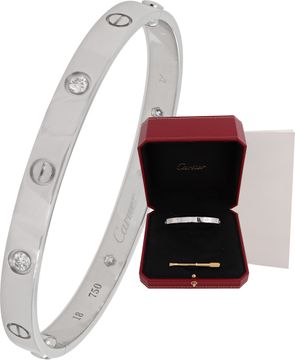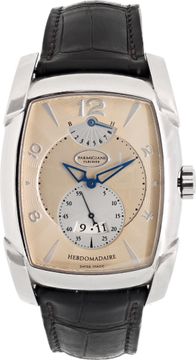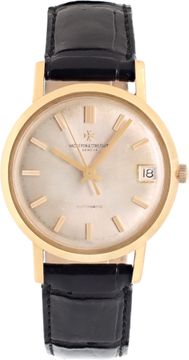Spotlight: Vintage Rolex Daytona “Big Red” 6265

In vintage watch collecting circles, the Rolex Daytona is in a league of its own. It’s actually an incredible turnaround story because when Rolex produced these now-vintage Daytona chronographs, they were not a popular choice at all. Today, however, vintage Daytona watches have achieved grail status among collectors, commanding eye-popping prices. A particularly sought out model within the vintage Daytona lineup is one that is aptly nicknamed the “Big Red.” Join us as we take a look at the history of the first generation of Rolex Daytona watches and shine a spotlight on the coveted vintage Rolex Daytona “Big Red” 6265.
The Origins of The Rolex Cosmograph Daytona
In 1963, Rolex presented a new chronograph model they dubbed the Cosmograph. While Rolex had already been producing chronograph watches since the 1930s, this represented the first time that the brand gave a specific name to a chronograph model. The first Cosmograph was the ref. 6239 and what you may not know, is that it was not a Daytona…yet. The Daytona name only joined “Cosmograph” on the dial in 1964 to emphasize Rolex’s partnership with the then-new Daytona Speedway in Florida and thus, linking the watch to the high-adrenaline world of motorsports. Fun fact: Rolex first called the Cosmograph the “LeMans” after the famous French endurance race but switched to “Daytona” to better speak to an American audience. Today, the Daytona name has completely taken over and although the watch is still officially called the Cosmograph Daytona, it is far more often simply referred to as the Rolex Daytona.

The vintage Daytona ref. 6239 sported a 37.5/38 mm case equipped with a duo of pump pushers on the case to activate the chronograph function on the dial. Rolex made stainless steel and yellow gold versions of the watch and regardless of the material, the watch featured a metal bezel engraved with a tachymeter scale. Rolex also made the Daytona ref. 6241, which was identical to the ref. 6239 except for the black bezel marked with a tachymeter scale. Whether in kilometers or meters, a tachymeter scale allows average speeds over a given distance to be measured using the chronograph seconds hand–a practical function at the racetrack.
A signature design detail of the Daytona was the use of contrasting registers on the dial. Making the trio of subsidiary dials in a different color to the main dial offered better legibility for the wearer. In addition to standard dials, Rolex also made ones they called “exotic dials,” now better known as “Paul Newman” dials since the famed actor and racecar driver regularly wore one. Some of the hallmarks of Paul Newman Daytona dials include a stepped minute track in a contrasting color, highly stylized subdials with Art Deco numerals and square tips, and the running seconds counter including 15/30/45/60 numerals instead of just 20/40/60. Daytona “Paul Newman” models are some of the most expensive vintage watches to collect today.

Inside the cases of vintage Daytona watches were manual wound movements, based on Valjoux calibers. Remember, automatic chronograph watches only made their debut in 1969, which is after the release of the first Cosmograph Daytona. However, even with the advent of self-winding chronograph movements, Rolex stuck to hand-wound movements for the Daytona line until the late 1980s.
The Evolution The Vintage Rolex Daytona
Following the ref. 6239 and the ref. 6241, Rolex unveiled the Daytona ref. 6240 in the mid-1960s. Sometimes referred to as a transitional or prototype reference, the Daytona ref. 6240 featured the screw-down chronograph pushers rather than the pump style pushers. This improved the water resistance of the Daytona, thus, the ref. 6240 was the first Daytona to include the “Oyster” label on the dial.

Next in line came the Daytona ref. 6262 with the metal bezel and the Daytona ref. 6264 with the black plexiglass bezel in the late 1960s. This pair of vintage Rolex Daytona watches went back to the pump chronograph pushers but included an upgraded movement inside the case. While it was still a manual-wound caliber, it operated at a higher frequency rate of 21,600 beats per hour (compared to 18,000 bph of the previous movements).
Finally, in the early 1970s, the last iterations of the manual Daytona made their appearance. (It’s worth pointing out that Rolex made some ultra lavish gold and diamond hand-wound Daytona models in the 1980s, but these were special-ordered and only a handful was made.) This pair included the Daytona ref. 6263 with the black bezel and the Daytona ref. 6265 with a metal bezel–and the subject of today’s spotlight.
Rolex Daytona “Big Red” 6265

What we’re looking at here is a Daytona ref. 6265 “Big Red”, circa 1979, in stainless steel with a silver dial.
Similar to the models that came before it, the vintage Daytona ref. 6265 features a case that measures just a hair under 38 mm, topped with a bezel engraved with the tachymeter scale. Rolex added the screw-down chronograph pushers to the case to ensure that the watch was indeed a waterproof “Oyster” version. Furthermore, while early versions of the Daytona ref. 6265 had a Twinlock screw-down winding crown, later editions included a bigger Triplock screw-down winding crown for an even better seal.

This reference also came with several different dial designs and this particular one here houses the sought-after “Big Red” dial, named so for the oversized red Daytona label arching over the subdial at 6 o’clock. The Panda style dial, with its silver background and black counters is highly attractive and it is accented with applied baton indices for hour markers and an applied Rolex crown. There are black dial versions of the Big Red too, but the silver Panda style is stunning. The vintage Rolex Daytona “Big Red” 6265 includes tritium lume plots running the periphery of the dial as indicated by the T SWISS T marking just below 6 o’clock.
Bracelet wise, this steel Daytona 6265 “Big Red” is fitted with a steel Oyster bracelet ref. 78350 with solid links and a lug width of 19 mm.

With its screw-down pushers, Panda dial, and large red font, this is a spectacular version of the now-iconic vintage Rolex Daytona. Due to its popularity, the Rolex Daytona 6265 “Big Red” is one that is becoming harder to come by in the secondary market and with looks like these, it’s easy to understand why.
The 20-Year-Old Patek Philippe Aquanaut 5066 A-001 Is Still Fresh
NEXT ARTICLE
50 years of Juste un Clou by Cartier






